Ohio is located to the northeast of the United States. To its south, there is Kentucky, and Lake Erie lies straight to the north. All these make the state of Ohio a super beautiful and appealing place for several species of owls to live.
Furthermore, Ohio features mainly the continental type of climate. However, some of the regions in the south have a sub-tropical climate. In other words, most parts of the state experience quite humid weather conditions, mostly during the summer, which attracts plenty of owls to this great state.
Typically, there are eight species of owls in Ohio that, as a bird enthusiast, you’d love to watch. They include; the Great Horned Owl, the Barn Owl, Eastern Screech-Owl, Barred Owl, Northern Saw-whet Owl, Snowy Owl, Short, and the Long-eared Owl.
If you are looking to learn more about these incredible owl species found in Ohio, then you’re surfing into the right site. This article discusses the features, looks, and areas you can find each of the above owl species. Without much further ado, let’s dive into our article.
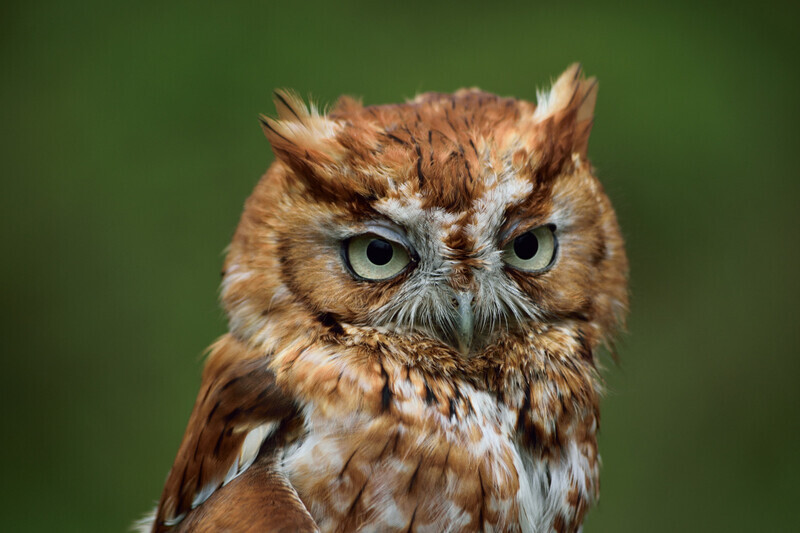
1. Eastern Screech-Owl (Megascops asio)
The Screech-owls are quite short, stocky, without necks. They are 6.3 to 9.8-inches long, weigh between 4.2 to 8.6oz, and their wingspan range from 18 to 21-inches. Besides that, these owls are either red or grey, with nearly a third of all the members being red. Those with grey feathers can easily camouflage in different tree species.
Eastern Screech-owls boast fake ear-tuffs at the sides of their heads, lying parallel to their eye line. These tufts can camouflage to split up their shape or moved around to pass information with other owls.
Since they are found everywhere in Ohio, these small owls are among the commonest owls in Ohio all time of the year. They are mostly found in very dense forests as they like areas with great tree cover to reside.
What’s more, Eastern Screech-owls often reside in nest boxes. You will find these birds active and can be heard at night-time. If need be, they will also look for food at dusk and dawn. They feed on a wide range of insects, rodents, squirrels, earthworms, lizards, tadpoles, songbirds, and other plenty species of small birds.
Regardless of their gender, these owls often look after their little offspring. When it comes to mating, a male Eastern Screech-owl will pair with one female. However, some may mate with even two females. The males also spend most of their time hunting for food and protecting their territory.
Interestingly, the Eastern Screech-owl make various sounds for calls, hoots, and songs. But, their pitched trill, usually called the tremolo, is used to keep pairs in touch. There’s so much to enjoy watching this owl species.

2. Great Horned Owl (Bubo virginianus)
This bird has a length of 18.1 to 24.8-inches, a weight of 32.1 to 88.0oz, and a wingspan of 39.8 to 57.1-inches. As a result, the Great Horned Owl comes as the second largest and most common owl species in Ohio. It usually has an orange or brown and fierce-looking face with contrasting lines of white and black along with grey feathers.
Like any other predator, this owl has a primary objective of not being seen. Therefore, you will find it with horizontal bars at the lower side, which mimics tree branches’ appearance when observed from the ground. Plus, it can camouflage the tree colors and look leafy when watched from above.
If you want to identify them, check out for long tufts of feathers that look like ears at their top head. Actually, these birds don’t have horns though their large ear tufts look like horns, hence their name. The Great Horned Owl also has fierce eyes, yellow ears, and it is pretty large.
Moreover, the Great Horned Owl is the only bird species that kills more often and feeds on larger animals to retain their huge bodies. For instance, they hunt rabbits, groundhogs, geese, rats, and many bird species. They can eat insects, reptiles, frogs, invertebrates, scorpions, and many other small preys. Most importantly, they eat skunks no wonder their nests and pellets smell skunks.
The good news for bird watchers is that this owl species is present in nearly every part of North America throughout the year. Practically, these birds can live in any habitat provided it has trees and rock-nesting sites. In addition, they can survive in rainforests, prairies, tundra, swamps, fringes, and urban areas.

3. American Barn Owl (Tyto furcata)
The Barn Owl is yet another beautiful and elusive owl you can find in Ohio any time of the year. With their heart-shaped face and elegant feathers, you can easily identify these birds. And you will find them 12.6 to 15.8-inches long, 14.1 to 24.7oz heavy, and their wingspan is between 39.4 and 49.2-inches.
Barn Owls love nesting in tons of human-made barns, hence their name. What’s more, they stand out as one of the most extensively spread birds not just in Ohio but also the rest of the world, with 46 different sub-species. Of all the sub-species, the North American Barn Owl exists as the largest.
Like other owls, Barn Owls are more active during the night and can be seen hunting small mammals. Their hearing ability is super good, and they can spot small prey beneath dense bush or snow with utmost ease.
Interestingly, these birds are best known for swallowing the entire prey, including the bones and everything. And instead of digesting the swallowed food in their digestive system, they vomit items their bodies don’t require to obtain nutrients.
They boast a unique screechy-like sound which is incredibly evocative of the red-tailed hawk. The males often show off for a female by clapping their wings together several times as they fly. These birds mate all their life even though they’ll stay monogamous to one female partner when it’s breeding season.
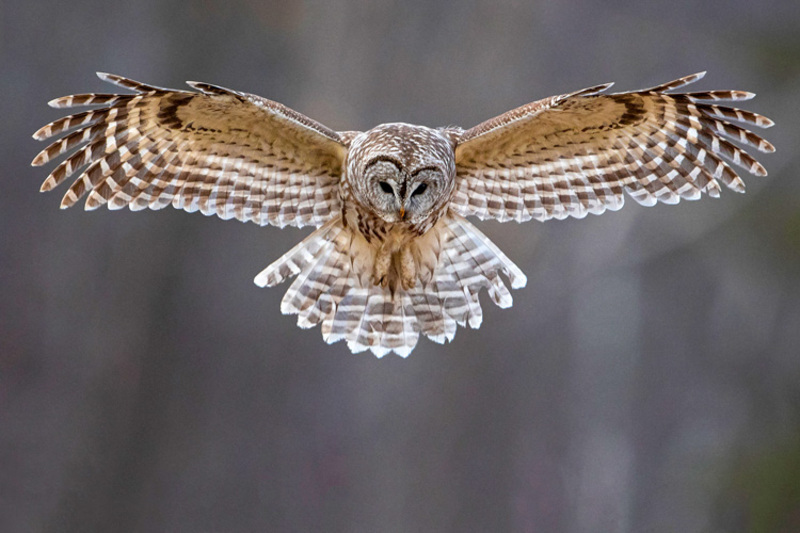
4. Barred Owl (Strix varia)
The Barred Owl is quite large with a length of 16.9 to 19.7-inches, a weight of 16.6 to 37.0oz, and a wingspan length of 39.0 to 43.3-inches. It is a common owl species you can find all over the state of Ohio, and it is more active during breeding periods. As the name suggests, this owl has bar patterned feathers in white and brown colors covering the entire body.
They are incredibly vocal and easily identified by their call, which sounds as if they are asking, “Who cooks for you?” “Who cooks for you all?” Like most owl species in Ohio, Barred Owls are not always easy to see.
You will find them very curious and interested, and most of the time, they’ll watch you pass near them during the day. In case they get nervous on approach, these birds will fly to an adjacent tree to continue watching around.
Furthermore, Barred Owls feed mostly on mice and other small-sized rodents. But, they’ll typically eat anything meaty. They also prey on rats, rabbits, squirrels, bats, minks, opossums, moles, frogs, snakes, fish, juicy insects, and a wide range of birds. While small birds like woodpeckers see Barred Owls predators, the Great Horned Owl sees them as prey.
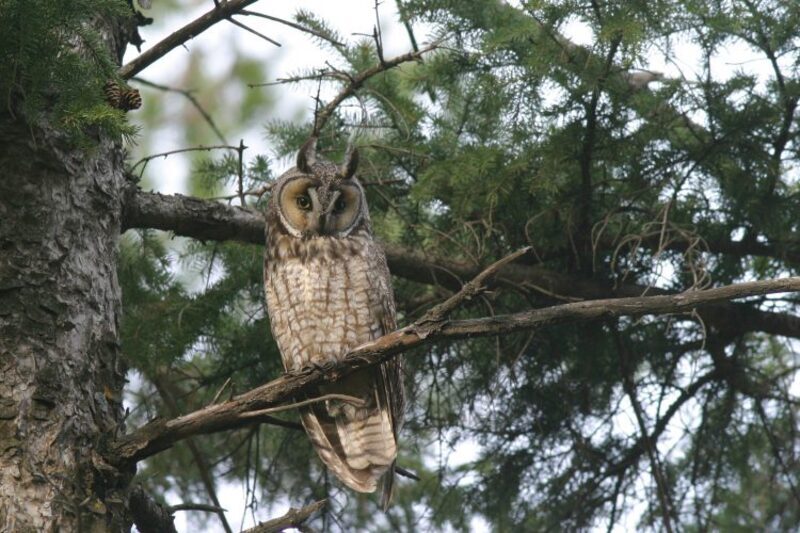
5. Long-Eared Owl (Asio otus)
As the name suggests, the Long-Eared Owls have long and pointed tufts. They are medium-sized with a length of 13.8 to 15.8-inches, weigh between 7.8 to 15.3oz, and have a wingspan of35.4 and 39.4-inches.
Other than that, their faces are orange in color, whereas their feathered bodies are dark. They are so secretive and rest in dense foliage and can easily camouflage, making it tricky to spot. However, the best way to spot them is to listen. In other words, the males are pretty talkative, especially during mating.
Long-eared Owls resides in Northeastern Ohio, although in other states, they’re categorized as non-breeding birds. Unfortunately, you can’t find them in Ohio throughout the year except when it’s the breeding period.
These birds can live comfortably in mixed forests with grooves of woodlands and conifers for nesting sites. Plus, they can access large open grassland suitable for hunting.
They are quite furious and silent hunters whose diet mainly consists of voles, including other kinds of small rodents. In case there’s a food shortage, these owls feed on little birds. Similar to Barn Owls, Long-eared Owls swallow the whole prey and regurgitate the non-essential pellets.
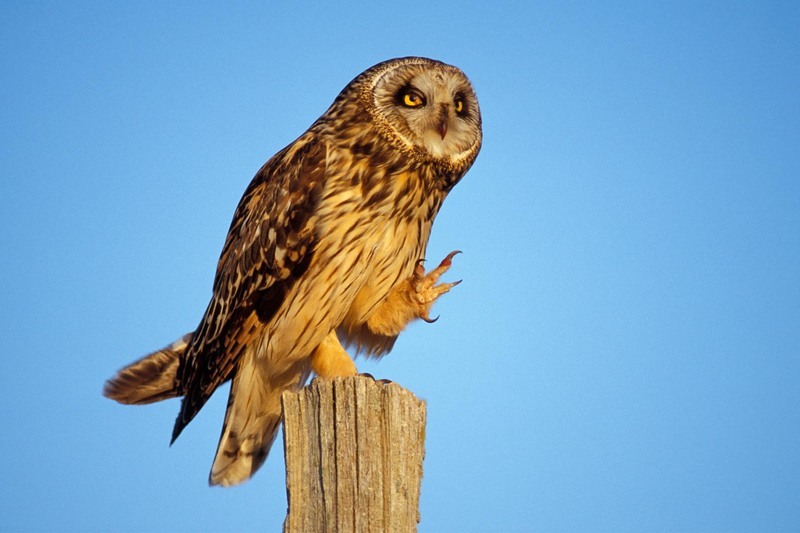
6. Short-Eared Owl (Asio flammeus)
The Short-eared Owl is 13.4 – 16.9-inches tall with a wingspan of 33.5 to 40.5-inches and 7.3 to 16.8oz heavy. It features very small ears that are not often visible since they lack ear tufts at all. Typically, these owls will only erect their small ears when they want to be seen as intimidating.
Asides from that, these owls are medium-sized, and their bodies covered with brown feathers spotted with buff. These birds create their habitats in vast areas open areas like meadows, prairies, savanna, or tundra.
And when it comes to breeding season, these owls hold a remarkable record of being active all day and night. You will find these owls with a non-breeding population spread out in Ohio, excluding the Northwestern parts where they are visible dusk or dawn all year round.
So, the best time to watch Short-eared Owls in Ohio is when they’re not breeding, especially from the end of November to mid-March. You will see them fly at great heights as they migrate to Mexico.
Short-eared Owls typically hunt during the day as their favorite meal, the voles, are active. On top of that, they prey rodents, seabirds if they’re closer to the ocean, and small songbirds. More importantly, these birds are less vocal and call with oddly and awful sounds.
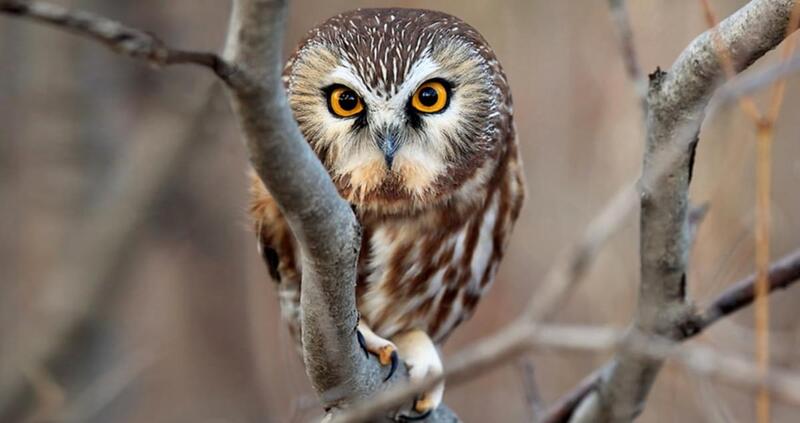
7. Northern Saw-Whet Owl (Aegolius acadicus)
The Northern Saw-whet Owl exists as one of the smallest owls in the world. They’re 7.1 to 8.3-inches tall, with a wingspan of 16.5 to 18.9-inches and weighs 2.3 to 5.3oz. Their big round and wide orange eyes make these birds easily identifiable.
You will find them with pale underbellies while their wings and backs are covered in brown feathers. Additionally, they boast an incredibly large range and always seek habitat in dense forests during winters and even breeding seasons.
And basically, the forests and woodlands should be near a river. Due to their selective nature for mature trees, the continued deforestation causes a drastic decline in their number.
Voles, deer mice, and shrews are their favorite foods. But, they often supplement their diet with insects, invertebrates, and small birds when needed. These owls get named because of the sound they make when alerted, which is similar to a saw’s whetting.
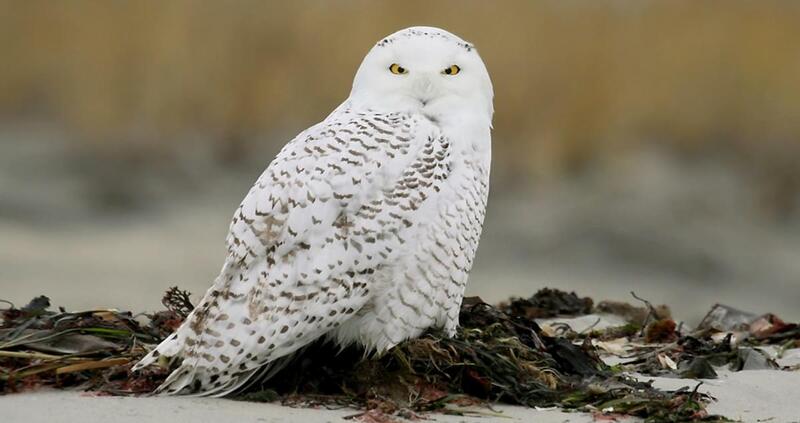
8. Snowy Owl (Bubo scandiacus)
Snowy Owls are not just one of the most attractive owls in Ohio, thanks to their white plumage feathers. This also enables them to camouflage in snow and hunt. They are also relatively larger than the Great Horned Owls with a length of 20.5 to 27.9-inches, a weight of 56.4 to 104.1oz, and a wingspan of 49.6 to 57.1-inches.
Moreover, Snowy Owls boasts rounded heads without ear tufts. So, it will be pretty hard to mistake them for any other owl species in Ohio. They also have horizontal dark lines throughout their bodies except for the face and breast region.
You will find these birds mostly in the north-most part of the state. Recently, they have been spotted quite often during winters on the southern shores of Lake Erie found in Ohio. More importantly, the Snowy Owls tend to migrate with varying seasons between summer and winters.
Their summertime food is often lemmings, whereas ptarmigan is for the tundra periods. When winter comes and forces them to the south, these owls’ diet becomes more diverse. They tend to prey on small birds, squirrels, rodents, rabbits, ducks, and seabirds.
The male Snowy Owls usually make a loud hoot when protecting their territory or looking for a mate. As for females, they hardly hoot. Both sexes make noises giving sounds like hissing, cackles, bill snapping, and shrieks.
Related
- Interested in more Ohio birds? Check out the Hawks in Ohio (9 Species Pictured), or the Hummingbirds In Ohio (7 Species Pictured).
- Owls are nocturnal, and it’s not all that unheard of to hear them making their calls late at night. Owls aren’t unique in this regard, however. Check out our article that looks into why certain birds choose to chirp at night.
Leave a Reply